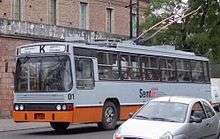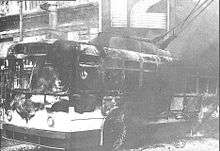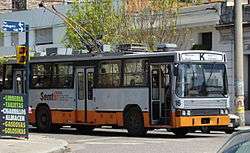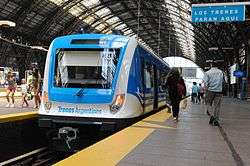Trolleybuses in Rosario
 | |
| Operation | |
|---|---|
| Locale | Rosario, Argentina |
| Open | 24 May 1959[1] |
| Status | Open |
| Routes | 1 (line K) |
| Operator(s) | Sociedad del Estado Municipal para el Transporte Urbano de Rosario (SEMTUR), since 2004[2] |
| Infrastructure | |
| Electrification | 600 V DC |
| Statistics | |
| Route length | 12.8 km (8.0 mi)[2] |
| Website | SEMTUR (Spanish) |
The Rosario trolleybus system (Spanish: Sistema de trolebuses de Rosario) is part of the public transport network in Rosario, the largest city in the province of Santa Fe, Argentina.[2]
Opened in 1959, the trolleybus system presently comprises one line, designated as line K.[3]
History
Early years
The Rosario system opened on 24 May 1959.[1][3] It replaced the old Rosario electric tramway network, which had been in existence since 1910. Initially, the system was operated by 10 German-made MAN trolleybuses.[3] They worked the first line G, which linked the Plaza Sarmiento with the intersection of Avenida San Martín and Saavedra, where there was a mini terminal for connections to the south. Over time, the line was extended to the intersection between Salta and Paraguay, then to Calle San Nicolás, and, two years later, to the Mariano Moreno bus station.
In late 1959, 40 trolleybuses were acquired from the Italian Fiat - Alfa Romeo - CGE consortium. On 15 April 1960, line H was opened, with a route running from the Plaza Sarmiento to the city's northern boundary, with Granadero Baigorria. Between August and December 1961, brand new Fiat trolleybuses arrived in Rosario, allowing network expansion with the creation of new lines. To reinforce the line H service, line J was opened in September 1961, and linked Plaza Sarmiento with Plaza Alberdi.
On 3 December 1961, line K began operating, from the corner of Necochea and Avenida Pellegrini to the corner of Mendoza and Nicaragua. Its fleet was composed entirely of Fiat units.
As with line H, line K experienced strong demand, which led to the opening of line L on 8 January 1962. Line L connected Pellegrini and Necochea with Bv. Avellaneda and Mendoza. At the request of residents, it was extended in 1964 to the corner of Paraná and 9 de Julio, in front of the Rosario Oeste railway station of the Ferrocarril General Manuel Belgrano.
In 1967, to optimize fleet utilization, lines G and J were merged, and line M opened to connect San Martín and Muñoz with the Santa Fe–Cafferata bus terminal. Following these changes, lines M, H and K were operating with 45 trolleybuses in total.
Decline

On 16 September 1969, during the protest movement known as the Rosariazo, eight Fiat vehicles were destroyed, and three MAN and 14 other vehicles were damaged to varying degrees. Following these events, services on line H were suspended, because the 32 surviving units could only cover the requirements of lines K and M.
In 1970, 12 Mercedes-Benz "0 km" trolleybuses (manufactured in 1953 for the city of Bahía Blanca, but not used there) entered the Rosario fleet, plus 11 vehicles that had been withdrawn from service in Mendoza. The arrival of these 23 units enabled the reintroduction of services on line H in 1971.
In 1979, during the military dictatorship (1976–1983), the trolleybus system was privatized. Around May 1980, the concessionaire acquired five large Soviet ZiU trolleybuses with three doors, but these vehicles had been poorly maintained, and were in service in Rosario for a very short time before being scrapped in 1984. During their limited time in service, they nevertheless created a great impression, due to their size and interior capacity, and air suspension. They had a front entrance door and two exit doors: one in the middle and another at the rear of the vehicle. Shortly after being put into service, the middle door was closed off.
After a long series of vicissitudes and mismanagement by the private concessionaire, the trolleybuses on the system were declining in quality of service and maintenance. They were gradually replaced by diesel powered units, and the trolleybus lines were either merged with other lines or eliminated.
On 31 December 1992, trolleybus services ceased on line K, the last Rosario trolleybus line still in operation.
Revival
Following a new call for tenders, the concession to operate line K was awarded in late November 1992 to a joint venture (Spanish: Unión Transitoria de Empresas (UTS)) composed of Capse SA (public lighting concessionaire) and Molino Blanco SRL (concessionaire of urban passenger transport lines 133 and 143). The joint venture then went on to be called ECO-Bus. Its concession was for a 15-year term, with an option for 5 more years.
The concessionaires were required to operate 20 trolleybuses, renovate feeder substations and make good the overhead wire network. They were also expected to extend the route network: Ciudad Universitaria at one end and Mendoza and Wilde at the other; the latter was partially extended, to Mendoza and Sanchez de Loria. Initially, the joint venturers were granted a period of 180 days to begin operating new trolleybuses, but that period had to be extended.
In 1994, the new trolleybuses arrived, with Volvo chassis, bodywork by Brazil's Marcopolo and electrical equipment by Powertronics. These vehicles had 0 km on the odometer, but had been kept in storage since being manufactured in Brazil in 1987 for a trolleybus system in Belo Horizonte that had not ultimately been completed.
After more than a decade of operations, and following the crisis of 2002, the company presented for bankruptcy due to an inability to pay workers' arrears. Trade union disputes coupled with a poor relationship between the concessionaires and the municipality were the triggers for the termination of the concession in October 2004. On the 25th of that month, line K passed into municipal control through Sociedad del Estado Municipal para el Transporte Urbano de Rosario (SEMTUR).
In June 2005, fully repaired trolleybuses returned to the streets of the city in SEMTUR's grey and orange colors. During the previous month, one of the vehicles in the fleet had succumbed to a fire while undergoing internal repairs. It was the first of the 1994-acquired trolleybuses to be withdrawn from service. Eventually, the fleet was recomposed with 14 cars operating the Semtur service in place of the 20 that had comprised the whole fleet.
Line
The only line presently in operation is line K. It is fitted with "Kummler & Matter" system elastic overhead contact line of 85–100 mm² diameter.
Fleet
The specifications of Rosario's current fleet of trolleybuses are as follows:

| Number and numbering | 20 units (Nº 1 to Nº 20) |
| Year of manufacture / commissioning | 1987 / 1994 |
| Chassis and mechanicals | Volvo (Brazil) |
| Bodywork | Marcopolo Torino |
| Electrical equipment | POWERTRONICS / AVIBRAS |
| Length / width / height | 12 / 2.54 / 3.48 m (from lowest point) |
| Passengers seated / total | 39 / 110 |
| Electrical control system | "Chopper" type electronics with fixed frequency |
| Traction motors / power output | Villares / 110 kW |
| Maximum speed | 60 km/h |
| Maximum acceleration | 1.3 m/s |
| Brakes / steering / suspension | Electric and pneumatic / hydraulic / pneumatic |
See also
References
- 1 2 Murray, Alan (2000). World Trolleybus Encyclopaedia, p. 81. Yateley, Hampshire, UK: Trolleybooks. ISBN 0-904235-18-1.
- 1 2 3 Webb, Mary (ed.) (2009). Jane's Urban Transport Systems 2009-2010, p. 6. Coulsdon, Surrey (UK): Jane's Information Group. ISBN 978-0-7106-2903-6.
- 1 2 3 Morrison, Allen (2011). The Trolleybuses of Latin America in 2011. Retrieved 15 October 2011.
Further reading
- Antenore, Mariano César (2004). Trolebuses Rosarinos [Rosario Trolleybuses] (in Spanish). Rosario: Asociación Rosarina Amigos del Riel. ISBN 9879734912.
External links
| Wikimedia Commons has media related to Trolleybuses in Rosario. |
- History of trolleybuses in Rosario (Spanish)
- "Trolleybus city: Rosario". Trolleymotion.
- Rosario database / photo gallery and Rosario trolleybus list at Urban Electric Transit – in various languages, including English.
This article is based primarily upon a translation of the Spanish language version as at October 2011.
